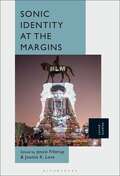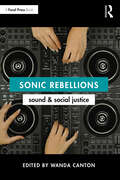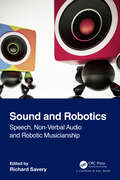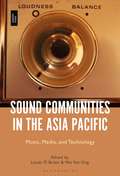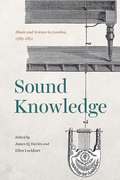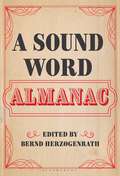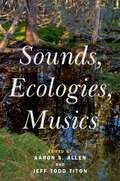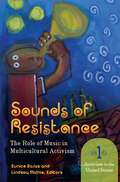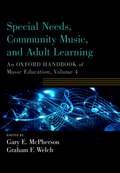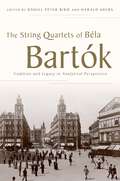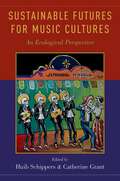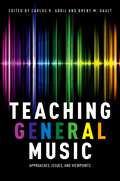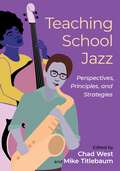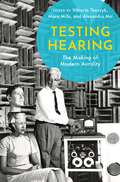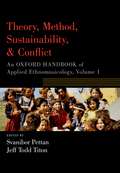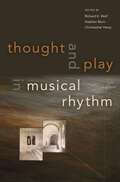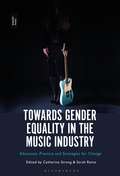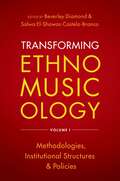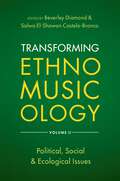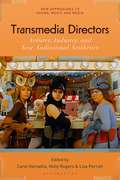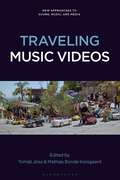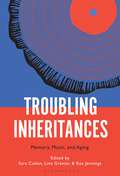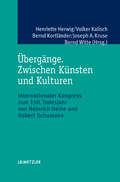- Table View
- List View
The Songs of Fanny Hensel
Fanny Hensel created some of the most imaginative and original music of her era, making her arguably the most gifted female composer of the nineteenth century. While Hensel has finally stepped out of the shadow of her famous brother, Felix Mendelssohn, as scholars have begun to study her life and writings, her music has remained surprisingly underexamined. This collection places Hensel's music at the center, focusing on the genre that not only made up more than half of her creative output but also, as Hensel herself put it, "suits her best": song. In eleven new essays, leading scholars in the fields of music theory and musicology consider Hensel's songs from a wide range of angles, covering topics such as Hensel's fascination with particular poets and poetic themes; her innovative harmonic, melodic, rhythmic, and textual strategies; and her connection to larger literary and musical trends. The chapters also provide insight into Hensel's efforts to break free from the constraints placed on her as a woman and her place in the larger history of the nineteenth-century Lied. Drawing on diverse biographical, historical, cultural, and musical contexts for their detailed discussions of Hensel's songs, the authors underline Hensel's historical importance and deepen our understanding and appreciation of her compositions. This volume, in short, finally gives Fanny Hensel and her songs the stage that they deserve.
Sonic Identity at the Margins
Sonic Identity at the Margins convenes the interdisciplinary work of 17 academics, composers, and performers to examine sonic identity from the 19th century to the present. Recognizing the myriad aspects of identity formation, the authors in this volume adopt methodological approaches that range from personal accounts and embodied expression to archival research and hermeneutic interpretation. They examine real and imagined spaces-from video games and monument sites to films and depictions of outer space-by focusing on sonic creation, performance, and reception. Drawing broadly from artistic and performance disciplines, the authors reimagine the roles played by music and sound in constructing notions of identity in a broad array of musical experiences, from anti-slavery songsters to Indigenous tunes and soundscapes, noise and multimedia to popular music and symphonic works. Exploring relationships between sound and various markers of identity-including race, gender, ability, and nationality-the authors explore challenging, timely topics, including the legacies of slavery, indigeneity, immigration, and colonial expansion. In heeding recent calls to decolonize music studies and confront its hegemonic methods, the authors interrogate privileged perspectives embedded in creating, performing, and listening to sound, as well as the approaches used to analyze these experiences.
Sonic Rebellions: Sound and Social Justice
Sonic Rebellions combines theory and practice to consider contemporary uses of sound in the context of politics, philosophy, and protest, by exploring the relationship between sound and social justice, with particular attention to sonic methodologies not necessarily conceptualised or practiced in traditional understandings of activism.An edited collection written by artists, academics, and activists, many of the authors have multidimensional experiences as practitioners themselves, and readers will benefit from never-before published doctoral and community projects, and innovative, audio-based interpretations of social issues today. Chapters cover the use of soundscapes, rap, theatre, social media, protest, and song, in application to contemporary socio-political issues, such as gentrification, neoliberalism, criminalisation, democracy, and migrant rights. Sonic Rebellions looks to encourage readers to become, or consider how they are, Sonic Rebels themselves, by developing their own practices and reflections in tandem to continue the conversation as to how sound permeates our sociopolitical lives.This is an essential resource for those interested in how sound can change the world, including undergraduates and postgraduates from across the social sciences and humanities, scholars and instructors of sound studies and sound production, as well as activists, artists, and community organisers.
Sound and Robotics: Speech, Non-Verbal Audio and Robotic Musicianship
Sound in human–robot interaction currently encompasses a wide range of approaches and methodologies not easily classified, analyzed or compared among projects. This edited book covers the state of the art in sound and robotics, aiming to gather existing approaches in a combined volume. Collecting chapters from world-leading academic and industry authors, Sound and Robotics: Speech, Non-Verbal Audio and Robotic Musicianship explores how robots can communicate through speech, non-verbal audio and music. The first set of chapters explores how robots use verbal communication, considering the possibilities of speech for human–robot interaction. The second section shifts to roles of non-verbal communication in HRI, including consequential sound, sonification and audio cues. The third and final section describes current approaches to robotic musicianship and their evaluation. This book is primarily aimed at HRI researchers, ranging from those who have never used sound to those very experienced with sound. Alongside robotic researchers, this book will present avenues for a diverse range of musicians, composers and sound designers to become introduced to the world of HRI and learn of potential creative directions in robotics.
Sound Communities in the Asia Pacific: Music, Media, and Technology
The popularization of radio, television, and the Internet radically transformed musical practice in the Asia Pacific. These technologies bequeathed media broadcasters with a profound authority over the ways we engage with musical culture. Broadcasters use this power to promote distinct cultural traditions, popularize new music, and engage diverse audiences. They also deploy mediated musics as a vehicle for disseminating ideologies, educating the masses, shaping national borders, and promoting political alliances. With original contributions by leading scholars in anthropology, ethnomusicology, sound studies, and media and cultural studies, the 12 essays this book investigate the processes of broadcasting musical culture in the Asia Pacific. We shift our gaze to the mechanisms of cultural industries in eastern Asia and the Pacific islands to understand how oft-invisible producers, musicians, and technologies facilitate, frame, reproduce, and magnify the reach of local culture.
Sound Knowledge: Music and Science in London, 1789-1851
What does it mean to hear scientifically? What does it mean to see musically? This volume uncovers a new side to the long nineteenth century in London, a hidden history in which virtuosic musical entertainment and scientific discovery intersected in remarkable ways. Sound Knowledge examines how scientific truth was accrued by means of visual and aural experience, and, in turn, how musical knowledge was located in relation to empirical scientific practice. James Q. Davies and Ellen Lockhart gather work by leading scholars to explore a crucial sixty-year period, beginning with Charles Burney’s ambitious General History of Music, a four-volume study of music around the globe, and extending to the Great Exhibition of 1851, where musical instruments were assembled alongside the technologies of science and industry in the immense glass-encased collections of the Crystal Palace. Importantly, as the contributions show, both the power of science and the power of music relied on performance, spectacle, and experiment. Ultimately, this volume sets the stage for a new picture of modern disciplinarity, shining light on an era before the division of aural and visual knowledge.
A Sound Word Almanac
This almanac of sound words important to artists and scholars highlights words that expand the way we speak (and write) about sonic experiences.Why write about sound, and how? If sonic philosophy is the attempt "to think about sound by philosophical means," then a metaphilosophical debate appears almost immediately on the horizon: What is called for is an understanding about sound and language, but also about the preconditions of musical understanding. What is at stake is the question of language and sound, as well as expanding how we speak about sonic experience.This almanac tackles these questions from artistic, experimental and personal perspectives. An assemblage of nearly 70 practitioners and theoreticians, artists and scholars offer their favorite 'sound word.' These sound words are onomatopoetical, mythological, practical; words of personal importance to the artists and their craft; words from their memory, related to sound. Many entries are not in English – some are untranslatable – and all are accompanied by a personal, explanatory, poetic entry. These are words that have the potential to change our perspective on listening-musicking-thinking.
Sounds, Ecologies, Musics
Sounds, Ecologies, Musics poses exciting challenges and provides fresh opportunities for scholars, scientists, environmental activists, musicians, and listeners to consider music and sound from ecological standpoints. Authors in Part I examine the natural and built environment and how music and sound are woven into it, how the environment enables music and sound, and how the natural and cultural production of music and sound in turn impact the environment. In Part II, contributors consider music and sound in relation to ecological knowledges that appear to conflict with, yet may be viewed as complementary to, Western science: traditional and Indigenous ecological and environmental knowledges. Part III features multidisciplinary and interdisciplinary approaches by scholars, scientists, and practitioners who probe the ecological imaginary regarding the complex ideas and contested keywords that characterize ecomusicology: sound, music, culture, society, environment, and nature. A common theme across the book is the idea of diverse ecologies. Once confined to the natural sciences, the word "ecology" is common today in the social sciences, humanities, and arts - yet its diverse uses have become imprecise and confusing. Engaging the conflicting and complementary meanings of "ecology" requires embracing a both/and approach. Diverse ecologies are illustrated in the methodological, terminological, and topical variety of the chapters as well as the contributors' choice of sources and their disciplinary backgrounds. In times of mounting human and planetary crises, Sounds, Ecologies, Musics challenges disciplinarity and broadens the interdisciplinary field of ecomusicologies. These theoretical and practical studies expand sonic, scholarly, and political activism from the diversity-equity-inclusion agenda of social justice to embrace the more diverse and inclusive agenda of ecocentric ecojustice.
Sounds of Resistance [2 volumes]: The Role of Music in Multicultural Activism [2 volumes]
From the gospel music of slavery in the antebellum South to anti-apartheid freedom songs in South Africa, this two-volume work documents how music has fueled resistance and revolutionary movements in the United States and worldwide.Political resistance movements and the creation of music—two seemingly unrelated phenomenon—often result from the seed of powerful emotions, opinions, or experiences. This two-volume set presents essays that explore the connections between diverse musical forms and political activism across the globe, revealing fascinating similarities regarding the interrelationship between music and political resistance in widely different geographic or cultural circumstances.The breadth of specific examples covered in Sounds of Resistance: The Role of Music in Multicultural Activism highlights strong similarities between diverse situations—for example, protest against the Communist government in Poland and drug discourse in hip hop music in the United States—and demonstrates how music has repeatedly played a vital role in energizing or expanding various political movements. By exploring activism and how music relates to specific movements through an interdisciplinary lens, the authors document how music often enables powerless members of oppressed groups to communicate or voice their concerns.
Special Needs, Community Music, and Adult Learning: An Oxford Handbook of Music Education, Volume 4 (Oxford Handbooks)
Special Needs, Community Music, and Adult Learning is one of five paperback books derived from the foundational two-volume Oxford Handbook of Music Education. Designed for music teachers, students, and scholars of music education, as well as educational administrators and policy makers, this fourth book in the set focuses on issues and topics that help to broaden conceptions of music and musical involvement, while recognizing that development occurs through many forms. The first section addresses music education for those with special abilities and special needs; authors explore many of the pertinent issues that can promote or hinder learners who share characteristics, and delve deep into what it means to be musical. The second section of the volume addresses music as a shared, community experience, and the diverse and constantly evolving international practice of community music. The chapters in the third section provide evidence that the process of music education exists as a lifelong continuum that encompasses informal, formal, and non-formal methods alike. The authors encourage music educators to think in terms of a music learning society, where adult education is not peripheral to the priority of other age groups, but is instead fully integral to a vision for the good of society. By developing sound pedagogical approaches that are tailored to take account of all learners, the volume endeavors to move from making individual adaptations towards designing sensitive 'universal' solutions. Contributors Carlos R. Abril, Mary Adamek, Kenneth S. Aigen, Chelcy Bowles, Mary L. Cohen, William M. Dabback, Alice-Ann Darrow, John Drummond, Cochavit Elefant, David J. Elliott, Lee Higgins, Valentina Iadeluca, Judith A. Jellison, Janet L. Jensen, Patrick M. Jones, Jody L. Kerchner, Thomas W. Langston, Andreas C. Lehmann, Katrina McFerran, Gary E. McPherson, David Myers, Adam Ockelford, Helen Phelan, Andrea Sangiorgio, Laya H. Silber, Marissa Silverman, Rineke Smilde, David S. Smith, Kari K. Veblen, Janice Waldron, Graham F. Welch
The String Quartets of Béla Bartók: Tradition and Legacy in Analytical Perspective
Béla Bartók (1881-1945) was one of the most important composers and musical thinkers of the 20th century. His contributions as a composer, as a performer and as the father of ethnomusicology changed the course of music history and of our contemporary perception of music itself. At the center of Bartók's oeuvre are his string quartets, which are generally acknowledged as some of the most significant pieces of 20th century chamber music. The String Quartets of Béla Bartók brings together innovative new scholarship from 14 internationally recognized music theorists, musicologists, performers, and composers to focus on these remarkable works from a range of theoretical and methodological perspectives. Focusing on a variety of aspects of the string quartets-harmony and tonality, form, rhythm and meter, performance and listening-it considers both the imprint of folk and classical traditions on Bartók's string quartets, and the ways in which they influenced works of the next generation of Hungarian composers. Rich with notated music examples the volume is complemented by an Oxford Web Music companion website offering additional notated as well as recorded examples. The String Quartets of Béla Bartók, reflecting the impact of the composer himself, is an essential resource for scholars and students across a variety of fields from music theory and musicology, to performance practice and ethnomusicology.
Sustainable Futures for Music Cultures: An Ecological Perspective
The sustainability of music and other intangible expressions of culture has been high on the agenda of scholars, governments and NGOs in recent years. However, there is a striking lack of systematic research into what exactly affects sustainability across music cultures. By analyzing case studies of nine highly diverse music cultures against a single framework that identifies key factors in music sustainability, Sustainable Futures for Music Cultures offers an understanding of both the challenges and the dynamics of music sustainability in the contemporary global environment, and breathes new life into the previously discredited realm of comparative musicology, from an emphatically non-Eurocentric perspective. Situated within the expanding field of applied ethnomusicology, this book confirms some commonly held beliefs, challenges others, and reveals sometimes surprising insights into the dynamics of music cultures. By examining, comparing and contrasting highly diverse contexts from thriving to 'in urgent need of safeguarding,' Sustainable Futures for Music Cultures analyzes sustainability across five carefully defined domains. The book identifies pathways to strategies and tools that may empower communities to sustain and revitalize their music heritage on their terms. In this way, this book contributes to greater scholarly insight, new (sub)disciplinary approaches, and pathways to improved practical outcomes for the long-term sustainability of music cultures. As such it will be an essential resource for ethnomusicologists, as well as scholars and activists outside of music, with an interest in the preservation of intangible cultural heritage.
Teaching General Music: Approaches, Issues, and Viewpoints
General music is informed by a variety of teaching approaches and methods. These pedagogical frameworks guide teachers in planning and implementing instruction. Established approaches to teaching general music must be understood, critically examined, and possibly re-imagined for their potential in school and community music education programs. Teaching General Music brings together the top scholars and practitioners in general music education to create a panoramic view of general music pedagogy and to provide critical lenses through which to view these frameworks. The collection includes an examination of the most prevalent approaches to teaching general music, including Dalcroze, Informal Learning, Interdisciplinary, Kodály, Music Learning Theory, Orff Schulwerk, Social Constructivism, and World Music Pedagogy. In addition, it provides critical analyses of general music and teaching systems, in light of the ways children around the world experience music in their lives. Rather than promoting or advocating for any single approach to teaching music, this book presents the various approaches in conversation with one another. Highlighting the perceived and documented benefits, limits, challenges, and potentials of each, Teaching General Music offers myriad lenses through which to re-read, re-think, and re-practice these approaches.
Teaching School Jazz: Perspectives, Principles, and Strategies
Written by an experienced and diverse lineup of veteran jazz educators, Teaching School Jazz presents a comprehensive approach to teaching beginning through high school-level jazz. Thoroughly grounded in the latest research, chapters are supported by case studies woven into the narrative. The book therefore provides not only a wealth of school jazz teaching strategies but also the perspectives and principles from which they are derived. The book opens with a philosophical foundation to describe the current landscape of school jazz education. Readers are introduced to two expert school jazz educators who offer differing perspectives on the subject. The book concludes with an appendix of recommended audio, visual, digital, and written resources for teaching jazz. Accompanied by a website of playing exercises and audio examples, the book is invaluable resource for pre- and in-service music educators with no prior jazz experience, as well as those who wish to expand their knowledge of jazz performance practice and pedagogy.
Testing Hearing: The Making of Modern Aurality
Testing Hearing: The Making of Modern Aurality argues that the modern cultural practices of hearing and testing have emerged from a long interrelationship. Since the early nineteenth century, auditory test tools (whether organ pipes or electronic tone generators) and the results of hearing tests have fed back into instrument calibration, human training, architecture, and the creation of new musical sounds. Hearing tests received a further boost around 1900 as a result of injury compensation laws and state and professional demands for aptitude testing in schools, conservatories, the military, and other fields. Applied at large scale, tests of seemingly small measure-of auditory acuity, of hearing range-helped redefine the modern concept of hearing as such. During the twentieth and twenty-first centuries, the epistemic function of hearing expanded. Hearing took on the dual role of test object and test instrument; in the latter case, human hearing became a gauge by which to evaluate or regulate materials, nonhuman organisms, equipment, and technological systems. This book considers both the testing of hearing and testing with hearing to explore the co-creation of modern epistemic and auditory cultures. The book's twelve contributors trace the design of ever more specific tests for the arts, education and communication, colonial and military applications, sociopolitical and industrial endeavors. Together, they demonstrate that testing as such became an enduring and wide-ranging cultural technique in the modern period, one that is situated between histories of scientific experimentation and many fields of application.
Theory, Method, Sustainability, and Conflict: An Oxford Handbook of Applied Ethnomusicology, Volume 1 (Oxford Handbooks)
The nine ethnomusicologists who contributed to this volume, balanced in age and gender and hailing from a diverse array of countries, share the goal of stimulating further development in the field of ethnomusicology. By theorizing applied ethnomusicology, offering histories, and detailing practical examples, they explore the themes of peace and conflict studies, ecology, sustainability, and the theoretical and methodological considerations that accompany them. Theory, Method, Sustainability, and Conflict is the first of three paperback volumes derived from the original Oxford Handbook of Applied Ethnomusicology, which can be understood as an applied ethnomusicology project: as a medium of getting to know the thoughts and experiences of global ethnomusicologists, of enriching general knowledge and understanding about ethnomusicologies and applied ethnomusicologies in various parts of the world, and of inspiring readers to put the accumulated knowledge, understanding, and skills into good use for the betterment of our world.
Thought and Play in Musical Rhythm
Thought and Play in Musical Rhythm offers new understandings of musical rhythm through the analysis and comparison of diverse repertoires, performance practices, and theories as formulated and transmitted in speech or writing. Editors Richard K. Wolf, Stephen Blum, and Christopher Hasty address a productive tension in musical studies between universalistic and culturally relevant approaches to the study of rhythm. Reacting to commonplace ideas in (Western) music pedagogy, the essays explore a range of perspectives on rhythm: its status as an "element" of music that can be usefully abstracted from timbre, tone, and harmony; its connotations of regularity (or, by contrast, that rhythm is what we hear against the grain of background regularity); and its special embodiment in percussion parts. Unique among studies of musical rhythm, the collection directs close attention to ways performers and listeners conceptualize aspects of rhythm and questions many received categories for describing rhythm. By drawing the ear and the mind to tensions, distinctions, and aesthetic principles that might otherwise be overlooked, this focus on local concepts enables the listener to dispel assumptions about how music works "in general." Readers may walk away with a few surprises, become more aware of their assumptions, and/or think of new ways to shock their students out of complacency.
Towards Gender Equality in the Music Industry: Education, Practice and Strategies for Change
Gender inequality is universally understood to be a continued problem in the music industry. This volume presents research that uses an industry-based approach to examine why this gender imbalance has proven so hard to shift, and explores strategies that are being adopted to try and bring about meaningful change in terms of women and gender diverse people establishing ongoing careers in music. The book focuses on three key areas: music education; case studies that explore practices in the music industry; and activist spaces. Sitting at the intersection between musical production, the creative industries and gender politics, this volume brings together research that considers the gender politics of the music industry itself. It takes a global approach to these issues, and incorporates a range of genres and theoretical approaches. At a time when more attention than ever is being paid to gender and music, this volume presents cutting edge research that contributes to current debates and offers insights into possible solutions for the future.
Transforming Ethnomusicology Volume I: Methodologies, Institutional Structures, and Policies
For decades, ethnomusicologists across the world have considered how to affect positive change for the communities they work with. Through illuminating case studies and reflections by a diverse array of scholars and practitioners, Transforming Ethnomusicology aims to both expand dialogues about social engagement within ethnomusicology and, at the same time, transform how we understand ethnomusicology as a discipline. The first volume of Transforming Ethnomusicology focuses on ethical practice and collaboration, examining the power relations inherent in ethnography and offering new strategies for transforming institutions and ethnographic methods. These reflections on the broader framework of ethnomusicological practice are complemented by case studies that document activist approaches to the study of music in challenging contexts of poverty, discrimination, and other unjust systems.
Transforming Ethnomusicology Volume II: Political, Social & Ecological Issues
For decades, ethnomusicologists across the world have considered how to effect positive change for the communities they work with when faced with challenging social, political, and environmental issues and institutional structures. The two-volume collection Transforming Ethnomusicology aims to deepen and broaden dialogues about social engagement within the discipline of ethnomusicology. Its many voices, from scholars and practitioners from diverse backgrounds and working in a variety of cultural situations, explore how ethnomusicology can transform the world by contributing to social change. Through their illuminating case studies and reflections, they at the same time transform how we understand ethnomusicology as a discipline. The second volume of Transforming Ethnomusicology provides much-needed new examinations of social and ecological concerns and centers around the recognition that colonial and environmental damages are intertwined and grounded in the failure to respect the land and its peoples. Featuring Indigenous perspectives from America, Australia, and South Africa, this volume critically engages with the question how ethnomusicologists can support marginalized communities in sustaining their musical knowledges and threatened geographies within institutional and historically-grown structures that have long worked toward their destruction. The volume ends with a radical model for change that is based on a profound rethinking of established structures of knowledge.
Transmedia Directors: Artistry, Industry and New Audiovisual Aesthetics (New Approaches to Sound, Music, and Media)
Transmedia Directors focuses on artist-practitioners who work across media, platforms and disciplines, including film, television, music video, commercials and the internet. Working in the age of media convergence, today's em/impresarios project a distinctive style that points toward a new contemporary aesthetics. The media they engage with enrich their practices – through film and television (with its potential for world-building and sense of the past and future), music video (with its audiovisual aesthetics and rhythm), commercials (with their ability to project a message quickly) and the internet (with its refreshed concepts of audience and participation), to larger forms like restaurants and amusement parks (with their materiality alongside today's digital aesthetics). These directors encourage us to reassess concepts of authorship, assemblage, transmedia, audiovisual aesthetics and world-building. Providing a vital resource for scholars and practitioners, this collection weaves together insights about artist-practitioners' collaborative processes as well as strategies for composition, representation, subversion and resistance.
Transpositions: Migration, Translation, Music (Contemporary French and Francophone Cultures #79)
This publication benefited from the support of the Institute for Scholarship in the Liberal Arts at the University of Notre Dame.This collective volume concentrates on the concept of transposition, exploring its potential as a lens through which to examine recent Francophone literary, cinematic, theatrical, musical, and artistic creations that reveal multilingual and multicultural realities. The chapters are composed by leading scholars in French and Francophone Studies who engage in interdisciplinary reflections on the ways transcontinental movement has influenced diverse genres. It begins with the premise that an attentiveness to migration has inspired writers, artists, filmmakers, playwrights and musicians to engage in new forms of translation in their work. Their own diverse backgrounds combine with their awareness of the itineraries of others to have an impact on the innovative languages that emerge in their creative production. These contemporary figures realize that migratory actualities must be transposed into different linguistic and cultural contexts in order to be legible and audible, in order to be perceptible—either for the reader, the listener, or the viewer. The novels, films, plays, works of art and musical pieces that exemplify such transpositions adopt inventive elements that push the limits of formal composition in French. This work is therefore often inspiring as it points in evocative ways toward fluid influences and a plurality of interactions that render impossible any static conception of being or belonging.
Traveling Music Videos (New Approaches to Sound, Music, and Media)
Traveling Music Videos offers a new interdisciplinary perspective on how contemporary music videos travel across, shape, and transform various media, online platforms, art institutions, and cultural industries worldwide. With the onset of digital technologies and the proliferation of global video-sharing websites at the beginning of the 21st century, music video migrated from TV screens to turn instead to the internet, galleries, concert stages, and social media. As a result, its aesthetics, technological groundings, and politics have been radically transformed. From the kinaesthetic experience of TikTok to the recent reimaginations of maps and navigation tools through music video cartographies, from the ecofeminist voices mediated by live-stream concerts to the transmedia logic of video games and VR, from the videos' role in contemporary art galleries to their political interventions -the chapters map the ways music video is continually reconfiguring itself. The volume tracks music video's audiovisual itineraries across different geographies, maps its transmedia routes, and tackles the cultural impact that it has on our current media ecosystem.
Troubling Inheritances: Memory, Music, and Aging
This book provides an interdisciplinary focus on music, memory, and ageing by examining how they intersect outside of a formal therapeutic context or framework and by offering a counter-narrative to age as decline. It contributes to the development of qualitative research methodologies by utilizing and reflecting on methods for studying music, memory, and ageing across diverse and interconnected contexts. Using the notion of inheritance to trouble its core themes of music, memory, ageing, and methodology, it examines different ways in which the concept of inheritance is understood but also how it commonly refers to the practice of passing on, and the connections this establishes across time and space. It confronts the ageist discourses that associate popular music predominantly with youth and that focus narrowly, and almost exclusively, on music's therapeutic function for older adults. By presenting research which examines various intersections of music and ageing outside of a therapeutic context or framework, the book brings a much-needed intervention.
Übergänge. Zwischen Künsten und Kulturen: Internationaler Kongress zum 150. Todesjahr von Heinrich Heine und Robert Schumann
Heine und Schumann im Wechselspiel von Literatur und Musik. Ausgehend von den vielen Berührungspunkten im Schaffen und Wirken der beiden Romantiker, haben Experten Beziehungen zwischen Musik, Bild und Literatur, Kunst- und Kulturkritik neu untersucht und eine Fülle überraschender Erkenntnisse formuliert.

